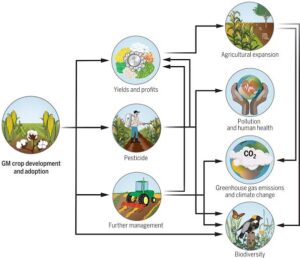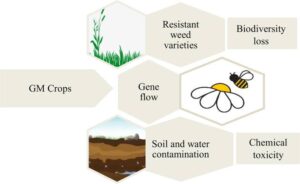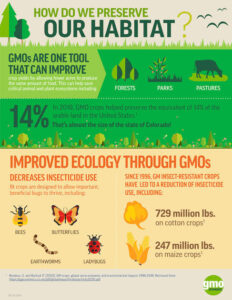Back to: Botany 400 Level
Welcome back, my brilliant Afrilearn scholar! I’m excited to have you back today as we explore a very important and timely topic—the effects of GM crops on biodiversity and ecosystems. This is one of those discussions where science, nature, and ethics all come together. Let’s take a closer look and understand why what we do with biotechnology can shape the world around us.
Effects of GM crops on biodiversity and ecosystems

Imagine a field full of genetically modified (GM) maize, grown to withstand pests, disease, and drought. It looks amazing, right? But what happens to the other plants, insects, and animals that depend on the natural balance of that environment? That’s the question we must ask when we talk about GM crops and their impact on biodiversity and ecosystems.
Biodiversity is the variety of life around us—plants, animals, and microorganisms that make ecosystems work. When we introduce GM crops, we may unknowingly change that balance. Let’s explore both the good and the not-so-good effects.
Positive Effects of GM Crops on Ecosystems
- Reduction in Chemical Use
GM crops, like Bt cotton, produce their own pest resistance, meaning farmers don’t need to spray as many chemical pesticides. This reduces chemical pollution in the soil and water, which helps protect non-target species like bees, birds, and aquatic life.
- Improved Agricultural Productivity
With the introduction of drought-resistant crops like drought-tolerant maize, farmers can grow more food with less water, which can help conserve natural water sources and reduce the pressure on wild habitats.
- Reduced Soil Erosion
Some GM crops are more resistant to diseases and pests, reducing the need to plough the soil repeatedly. Less ploughing helps prevent soil erosion, preserving soil fertility and ecosystem health.

Negative Effects of GM Crops on Ecosystems
- Gene Flow and Crossbreeding
One concern with GM crops is that they can crossbreed with wild relatives, creating hybrids that may outcompete native species. For example, GM crops with herbicide resistance might pass that resistance to wild plants, making them harder to control.
- Loss of Natural Habitats
To make room for large-scale GM crop production, forests, wetlands, and other ecosystems might be cleared. This destroys the natural habitats of countless species and can reduce overall biodiversity in the area.
- Impact on Non-Target Species
While Bt crops are designed to kill specific pests, there’s concern that they might also harm beneficial insects, such as ladybugs or bees, which play vital roles in pollination and pest control. The unintended loss of these species can have a ripple effect throughout the ecosystem.
Let’s say a local farmer in Osun state grows genetically modified maize that’s resistant to pests. This reduces the need for pesticide sprays, which is great for reducing pollution. But imagine that the maize plants accidentally cross-pollinate with nearby wild grass species, creating new plants that resist herbicides. Over time, the wild plants might become tougher to manage, and farmers might face new challenges in controlling them. This is a potential concern for biodiversity.

Why This Is Important
- Protecting the environment: GM crops must be studied thoroughly to ensure they don’t harm the delicate balance of ecosystems.
- Maintaining biodiversity: It’s crucial that new technologies don’t endanger the variety of life that sustains us all, from soil microbes to animals and plants.
- Sustainability: We need to make sure the solutions we create are good for the long-term health of the planet.
Summary
- GM crops can reduce chemical use, improve productivity, and protect soil, but they can also risk gene flow, habitat loss, and harm to non-target species.
- It’s essential to weigh both the positive and negative impacts on biodiversity and ecosystems before adopting GM technology.
- Balancing the benefits of GM crops with the need to preserve the environment is key to sustainable farming.
Evaluation
- How can GM crops help reduce chemical use in farming?
- What is the risk of gene flow in GM crops?
- Why is biodiversity important when introducing GM crops into an ecosystem?
Understanding the impact of biotechnology on ecosystems shows how responsible and thoughtful you are about the future. Your knowledge is not just academic; it’s about making sure the world we live in thrives alongside innovation. You’re learning not just for yourself but for your community and the planet. Keep up the great work—you’re ready to make a positive difference in science and the world around you! Let’s keep moving forward together!
